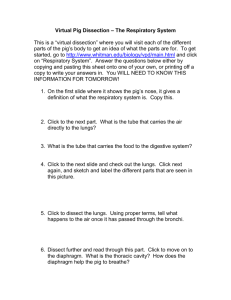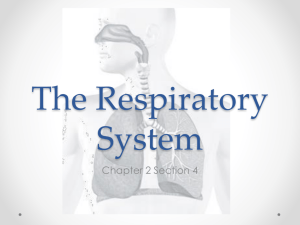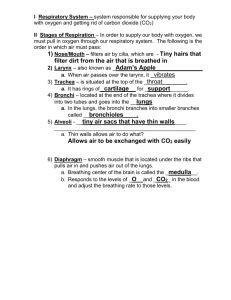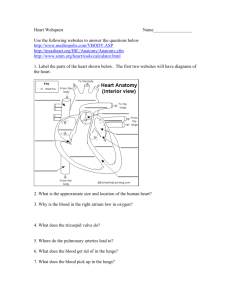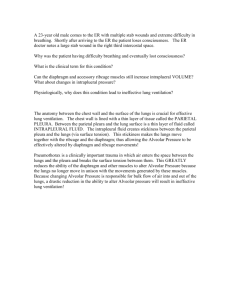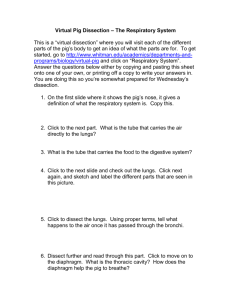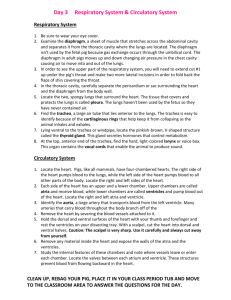click here - Conn
advertisement
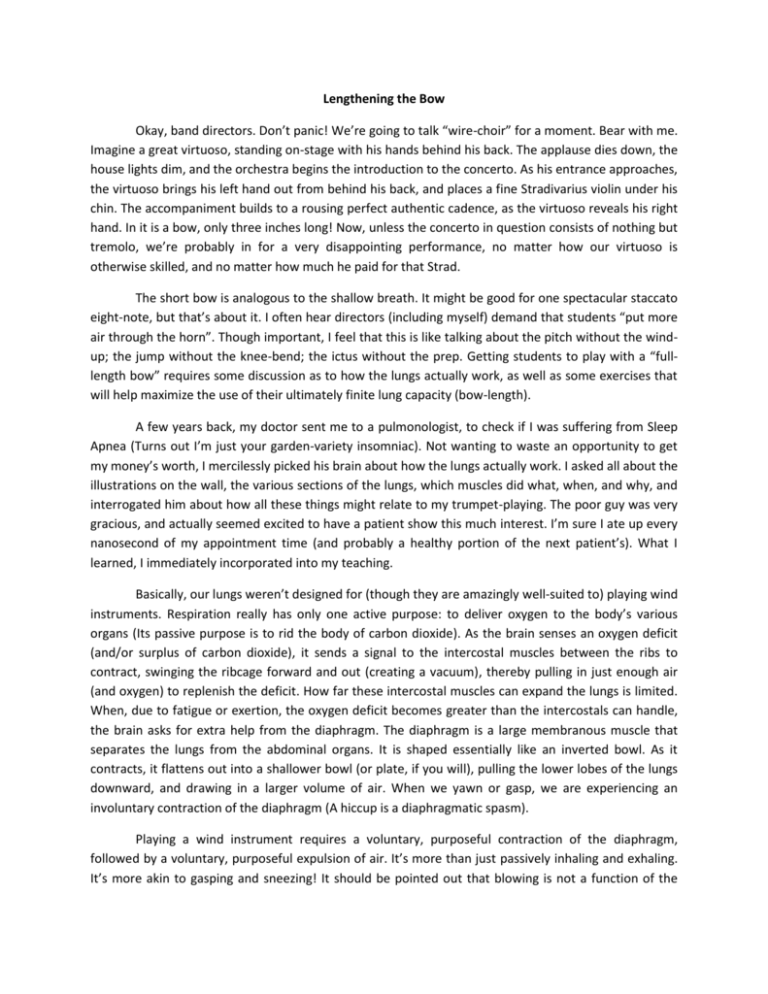
Lengthening the Bow Okay, band directors. Don’t panic! We’re going to talk “wire-choir” for a moment. Bear with me. Imagine a great virtuoso, standing on-stage with his hands behind his back. The applause dies down, the house lights dim, and the orchestra begins the introduction to the concerto. As his entrance approaches, the virtuoso brings his left hand out from behind his back, and places a fine Stradivarius violin under his chin. The accompaniment builds to a rousing perfect authentic cadence, as the virtuoso reveals his right hand. In it is a bow, only three inches long! Now, unless the concerto in question consists of nothing but tremolo, we’re probably in for a very disappointing performance, no matter how our virtuoso is otherwise skilled, and no matter how much he paid for that Strad. The short bow is analogous to the shallow breath. It might be good for one spectacular staccato eight-note, but that’s about it. I often hear directors (including myself) demand that students “put more air through the horn”. Though important, I feel that this is like talking about the pitch without the windup; the jump without the knee-bend; the ictus without the prep. Getting students to play with a “fulllength bow” requires some discussion as to how the lungs actually work, as well as some exercises that will help maximize the use of their ultimately finite lung capacity (bow-length). A few years back, my doctor sent me to a pulmonologist, to check if I was suffering from Sleep Apnea (Turns out I’m just your garden-variety insomniac). Not wanting to waste an opportunity to get my money’s worth, I mercilessly picked his brain about how the lungs actually work. I asked all about the illustrations on the wall, the various sections of the lungs, which muscles did what, when, and why, and interrogated him about how all these things might relate to my trumpet-playing. The poor guy was very gracious, and actually seemed excited to have a patient show this much interest. I’m sure I ate up every nanosecond of my appointment time (and probably a healthy portion of the next patient’s). What I learned, I immediately incorporated into my teaching. Basically, our lungs weren’t designed for (though they are amazingly well-suited to) playing wind instruments. Respiration really has only one active purpose: to deliver oxygen to the body’s various organs (Its passive purpose is to rid the body of carbon dioxide). As the brain senses an oxygen deficit (and/or surplus of carbon dioxide), it sends a signal to the intercostal muscles between the ribs to contract, swinging the ribcage forward and out (creating a vacuum), thereby pulling in just enough air (and oxygen) to replenish the deficit. How far these intercostal muscles can expand the lungs is limited. When, due to fatigue or exertion, the oxygen deficit becomes greater than the intercostals can handle, the brain asks for extra help from the diaphragm. The diaphragm is a large membranous muscle that separates the lungs from the abdominal organs. It is shaped essentially like an inverted bowl. As it contracts, it flattens out into a shallower bowl (or plate, if you will), pulling the lower lobes of the lungs downward, and drawing in a larger volume of air. When we yawn or gasp, we are experiencing an involuntary contraction of the diaphragm (A hiccup is a diaphragmatic spasm). Playing a wind instrument requires a voluntary, purposeful contraction of the diaphragm, followed by a voluntary, purposeful expulsion of air. It’s more than just passively inhaling and exhaling. It’s more akin to gasping and sneezing! It should be pointed out that blowing is not a function of the diaphragm. By contracting, it can take in air, hold in air, or control the release of air, but it cannot push air out. Forcefully expelling air is largely a function of the abdominal muscles literally pushing the lungs back up (again, aiding the intercostals). The rate and steadiness of expulsion is ultimately a balancing act between the diaphragm and the abdominals. This active, controlled expulsion of air is what we commonly call “breath support”. So, getting back to the violin bow analogy, we need to not only use a full-length bow, but learn how to use the entire bow, from frog to tip. This is not necessarily about increasing lung capacity. The length of a violin bow (twenty-five and a quarter inches) is finite, and so is the capacity of our lungs. They are really more like a Mylar balloon than a latex balloon, in that they don’t so much stretch as just fill up. But we can strengthen the diaphragm, and increase its ability to go from a bowl to a plate, thereby allowing the lungs to fill to maximum capacity. For nearly thirty years, I have been using the following exercises (as part of our daily warm-ups) to help my bands “fill all the corners” with air, and control and support their output. The first exercise is called “Sips”. Its purpose is purely to tone the diaphragm and abdominals. In any body-building endeavor, we build muscle by working against resistance, whether by lifting weights or by stretching an elastic spring or cord. To create resistance for the diaphragm to work against, we have to create a smaller space for the air to pass through. This is accomplished by violently “sipping” air through an imaginary straw (Not one of those big smoothie straws you could suck a raspberry through; rather, one of those itty-bitty coffee-stirrer straws). We start with eight sips, executed as eight staccato quarter-notes. These sips should be loud! I tell my students that it should sound like “extreme kissing”. If it’s not loud, they’re either not sipping hard enough, or their straw is too big. Ideally, they should feel absolutely full by the sixth sip, with two more to try and “fill the corners”. These eight sips are followed by eight counts of expelling the air as a hiss, executed as two tied whole-notes. The hiss creates resistance for the abdominals to work against, and is also a good barometer as to steady breath control. All eight counts of the hiss should be at the same pitch and intensity, not starting loud and high and ending soft and low. We call this “squeezing the balloon”. When we first release the air, the pitch and intensity will naturally be high, due to the inherent elasticity of the muscles involved. We have to control the release with the diaphragm, while using the abdominals to keep the pressure on. So, the entire exercise sounds like: “sip, sip, sip, sip, sip, sip, sip, sip, ssssssssssssssssssssssssssssssss” (repeat as necessary). Next, we do an exercise called “Deep Yawns”. Now we’re trying to eliminate resistance, while training the lungs to fill from the bottom up. Students place one hand on their belly, with the other hand on their upper chest. This is so they can really feel their belly rise first, as they work to fill the lower lobes of the lungs. We start by once again inhaling for eight counts, but this time in two whole notes: four counts to fill the belly; four counts to fill the chest. The air is pulled in steadily through a very openthroated “yawn”. It is then released through an eight-count hiss, just like in the Sips exercise. After executing the exercise as four low/four high a couple of times, we reduce it to three low/three high (always hissing for eight counts), then two low/two high, and one low/one high. Finally, we try executing the inhale in just one count, with the lungs still filling low to high. Unlike the Sips exercise, it is important to make the inhale as quiet as possible, through a wide-open throat, but the hiss should still be nice and steady. If the hisses are getting softer each time, the students need to be reminded to take in just as much air, even when they have only one count in which to do it. The final exercise, “Timing Breaths”, is somewhat similar to Deep Yawns, in that the amount of time available to inhale gets reduced throughout. In fact, we usually do Sips every day, but alternate between Deep Yawns and Timing Breaths every other day. This last exercise always occupies eight counts per segment. We start by saying “dut-dut” over two staccato eighth-notes, occupying count one. The students then have all of counts two, three, and four to do an open-throat inhale. They then exhale a four-count hiss, immediately repeating the exercise on the next eight counts. Then we extend to four eighth-notes, inhaling on counts three and four. Next, six eighth-notes, inhaling on count four. The final challenge is to say seven eighth-note “duts”, using only the “and” of count four to take in a lungful of air, before executing the final hiss. Gradually increasing the tempo while continually repeating this last step makes for lots of challenging fun! All of the above exercises can of course be executed with long-tones replacing the hissing. In marching band, we will often perform them in conjunction with our marching fundamentals, involving the percussion and color guard as well, as they can benefit greatly from both the timing and athletic endurance involved. We generally go with a very moderate tempo of about 100 bpm (Just like in CPR, the Bee-Gees “Stayin’ Alive” is a great template). Once the more mature students are consistently filling their lungs to capacity (both in exercise and performance), we return to the bow analogy. When a string player plays with a full bow, she doesn’t actually start right at the frog. Rather, she starts about an inch away from it, where the very edge of the sweet spot begins. It’s much the same way with our breathing. In performance, one can overfill the lungs to a point where there is a lack of control in the initial attack. So, we train the lungs through exercise to accept more and more air, but hold back just a touch in performance. Trumpeter Wayne Bergeron (whom we hear on “The Incredibles” soundtrack and with the Gordon Goodwin Big Phat Band) describes it as filling up only about eighty percent of his total capacity in performance, though he may continually stretch in his personal practice. But again, I only mention this last bit of esoteric treatment to my students once their reach is exceeding their grasp, and I think they are mature enough to handle it. Incorporating these concepts early and consistently has greatly benefitted all of my groups’ sonority, phrasing, and even intonation. Now, if we start a Bach chorale and it’s sounding a bit anemic, I simply stop the group and say “Sips”. After we do a breathing exercise or two, we begin again, and it sounds like I literally switched bands. -Dan Moore Naperville North

